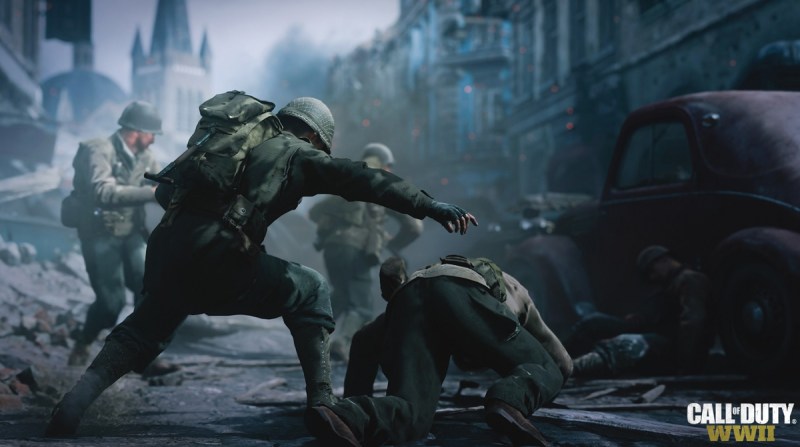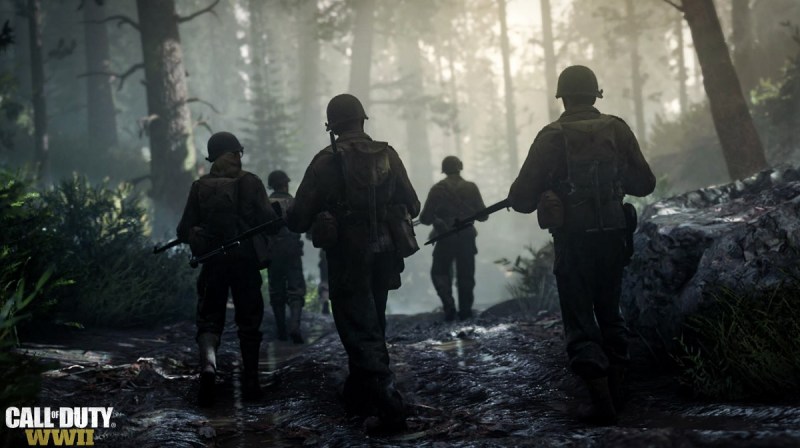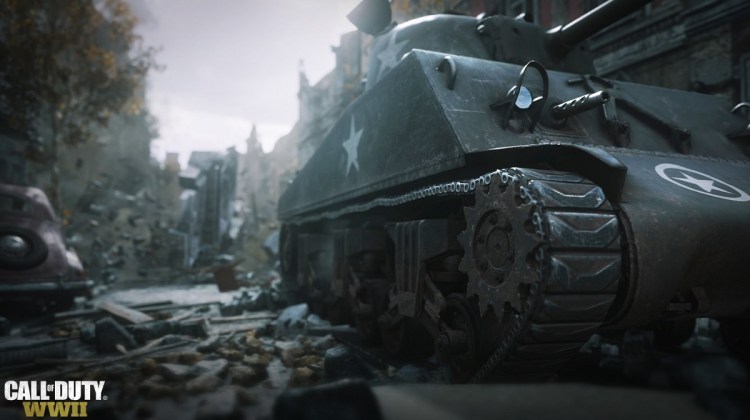
Above: The graphics have been taken up a notch in Call of Duty: WWII.
GamesBeat: How many different sounds are overlapping there?
Swenson: Quite a few. [Laughs] The real trick when we’re mixing is to make sure not too many sounds overlap. The consoles have gotten to a point such that we’re not really limited by how many sounds we can play. Now we can use tons, and so what we have to do—it’s more about crafting the exact sound treatment we want. It’s about not playing everything all at once, but playing the right things at the right time so the mix can breathe. You feel the dynamics in it. When you hear the wood clatter on the ground, there’s room in the mix so you can hear those specific, unique elements.
GamesBeat: Did you do much recording in historical locations? Or does it work to use environments closer to home?
Swenson: We do travel, but we’re also continually recording. It’s not as if we just went out one week and did all our recording and then came home to make the game. It’s part of our process. This forest where we recorded the wood breaking, that’s a redwood forest about 10 minutes from the office. As we’re working on a sequence like that, we might say, “Oh, I need to do this other sound.” We can jump up and get in the car and be in the forest recording it and working on it 15 minutes later. Being able to use locations that are close to us, and that have about the same makeup as the historical locations, that allows us to work on location much more frequently and make that an integrated part of our process.
June 5th: The AI Audit in NYC
Join us next week in NYC to engage with top executive leaders, delving into strategies for auditing AI models to ensure fairness, optimal performance, and ethical compliance across diverse organizations. Secure your attendance for this exclusive invite-only event.
GamesBeat: Breathing is something I noticed a lot. Guys get out of breath, or they’re breathing hard. You don’t always catch on to that in a game.
Swenson: This is the first time, for this team, that we had the player actually have a voice and have dialogue. As part of that, we wanted you to hear his breathing. When you run up the beach at Normandy, what kind of noise would you make? Would you be out of breath? Would it be stressful and chaotic? What would it be like? We spent a lot of time recording a lot of breathing with our actors and building a system in the game engine that would watch the moments of the game and procedurally adjust that sound to whatever the game is throwing at the player. In a sequence like this, which is crazy and chaotic, really stressful breathing would be playing, as opposed to when you’re just walking along.
GamesBeat: Is it almost more like a motion capture environment, where you’d have them do something and record how they react at the same time?
Swenson: For the breathing stuff, we actually did—it’s tricky to record, because it’s so quiet. You need to record it in a quiet environment. We did it in a sound studio, like one of these rooms, where it’s totally silent. You can record it and get all the details. We’d have the actors do a lot of movement in these rooms to get tired out. But that said, every time we can do recording in the environments, we do. Our footsteps in the game, for example—the player walks and runs over all kinds of terrain. Those are the kinds of things where we go out and hold up our mikes and run over those surfaces. We’re jumping over logs as we run through the forest.
A great example is at the beginning of some of the capture you saw today. The player’s sneaking along a river in the forest. We wanted to get great-sounding footsteps for moving through a river, but California was still in the middle of a drought. We couldn’t find any rivers with enough water in them. You can fake that in a pool or something, but we wanted to do it in a river in the forest. It happened that I was out camping and I’d gotten in late at night, so I didn’t see much of what was around me. I just got in my tent and went to sleep. When I got up in the morning, I got out of my tent, and there was a river there.
All of our sound designers carry a recorder all the time, in case we stumble on stuff like that. So I walked out of my tent, put sandals on, and started recording. This is that morning. I found this stream and thought, “Oh, that’s perfect.” I just started walking up and down the stream recording. A simple thing like that, but it’s in the forest, in the right environment, the right type of stream that’s in the game. Now, as you play the game, it’s that same recording of me walking up the stream in my sandals. But it’s very immersive.

Above: You are part of a squad in the 1st Infantry Division in Call of Duty: WWII.
GamesBeat: How much of this is different from how you worked on Advanced Warfare? What kinds of things are more refined or detailed?
Swenson: We started from scratch. Advanced Warfare was futuristic enough that it had a certain sound to it. Even the explosions that we recorded and designed, they sounded kind of future-ey. The equipment is completely different. These guys are all wearing historic gear. So we ended up deciding it would be best to just retire all that old sound, even though it was awesome, and start over so we could customize everything for the historic experience.
It required a lot of recording, because now every footstep, every splash in the water, every explosion, every gunshot, has to be recorded anew. But by doing that, we were able to get the right stuff in the right environments. Everything is authentic. Every gun you hear, we went and recorded that weapon in the proper environment. Every detail is important, so it’s even down to the foley of the weapons, how they sound when you handle them.
This is a replica of a Kar 98. The barrel is solid, so it doesn’t fire, but everything else about it is in working order. When we’re recording, the sound of the player running with his gun—you get the right kind of rattle. As he pulls the bolt back and works the action, we can record all those things and make them very accurate. This MP 41 has this great sound when you rack it. It’s very weighty. As the player uses the weapons in the game, we have all this great content to make it feel realistic, all the way down to those fine details.
GamesBeat: It sounds like there has to be hours and hours of recordings.
Swenson: Thousands and thousands of unique sounds. A couple of my favorite things to record for this game—there are big things and little things. The big things are like the tanks. Tanks are these huge vehicles. They have a lot of intricate sounds going along with them. We spent a lot of time trying to make that sound great.
We ended up realizing, as we were recording, we wanted to break the components of it apart. The first thing we did was we went and recorded a tank. We all climbed in and put our mikes everywhere, and you can see in this video what it looked like. As it started driving we had mikes boomed over the edge to get the sounds of the treads on the ground as we moved over hills, doing tight turns. We knew that in the game we’d have this experience for the player.
As I was riding the tank, I was thinking about how this engine sound was really cool. “I wish I could get some time with just the engine, without everything else.” We did some digging to see if we could find just a tank engine, and on YouTube I found this guy who had a two-stroke Detroit diesel out on blocks. He could rev it and almost play it like an instrument without it moving around and having all that extra noise involved. I found out who this guy was and I emailed him. “Hey, can I come record your engine?” He was really open to it, so he let us come to his place. Here we are a couple of months later, and now we have all our mikes set up. We could stay there all day long and have him really rev the engine up and make it do every unique sound I wanted.
The last component I wanted for the tank was to have really great creaking metal sounds. It’s an old tank. It’s been in combat. Every time it turned I wanted it to groan and creak and almost sound like a living thing. I went and found an abandoned building in San Francisco. The first thing I did was drop railroad ties off the second story, because that’s what you do if you own an abandoned building. We got these great recordings of crashing. That was super fun.
But then I found this great air conditioning vent. I started moving and manipulating it, and it made this really cool grinding metal sound. The whole time I was doing that, I thought, “Man, this is the tank. This is what the tank should sound like. Whenever it turns and moves, it should have this really gritty metal sound to it.” When you combine all that together – the tank treads, the engine, all these metal groans – you end up with our tank in the game. This is what it ends up sounding like. You hear the treads and the metal and the engine. When it makes that turn you hear the metal. That’s all the parts that go into a sequence like that, which is pretty exciting.
And then down to the little things—in the trailer you saw the big bell tower collapsing. We were trying to figure out how we’d record a bell in a tower crashing down. We spent a lot of time, again, recording wood destruction. We have this big chunk of wood that we would throw on the ground and get big, beefy, weighty recordings. Then, for the bell, one of my lead sound designers had this idea to get this dense, heavy pot from home. We started banging it on stuff, dropping it, hearing it thump. He found this bike lock that had a rubber coating on it, so we could hit it and make all these interesting bell-ish sounds. Then we’d pitch those down and put a little reverb on them. That’s what ends up being the bell tower collapse.
As you listen to this, every bell sound you hear in the sequence is just that pot right there as we’re banging it around. We put all that together with the wood chunks, the wood breaking, and you end up with a pretty cool bell tower sequence.

